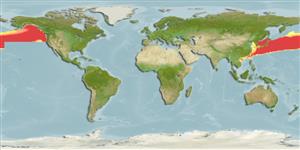>
Aulopiformes (Grinners) >
Scopelarchidae (Pearleyes)
Etymology: Benthalbella: A possible interpretation is related to Greek, benthos = the deep sea + Latin, albus = white; but it is need more information.
Environment: milieu / climate zone / depth range / distribution range
पारिस्थितिकी
समुद्री बैथीपिलाजिक; गहराई सीमा 10 - 2294 m (Ref. 44036). Deep-water
North Pacific. South China Sea (Ref.74511).
आकार / वज़न / Age
Maturity: Lm ? range ? - ? cm
Max length : 7.8 cm SL पुल्लिंग / अलिंग; (Ref. 28981)
Usually live 305 m or more below the surface but move upward in the water at night, sometimes to relatively shallow depths. Are believed to be rapid swimmers, skillful at avoiding nets, which would account for the scarcity of large adults in research collections. Juveniles feed heavily on crustaceans, while adults feed mainly on fish (Ref. 4525).
Life cycle and mating behavior
परिपक्व अवधि | पुनरुत्पत्ति | मछलीऔ का अंडे देना | अंडे | Fecundity | लार्वा
McAllister, D.E., 1990. A list of the fishes of Canada. Syllogeus No. 64. Nat. Mus. Nat. Sci., Ottawa, Canada. 310 p. (Ref. 11980)
IUCN Red List Status (Ref. 130435: Version 2024-1)
Threat to humans
Harmless
Human uses
साधन
Special reports
Download XML
इंटरनेट स्रोत
Estimates based on models
Preferred temperature (Ref.
123201): 0.3 - 12.8, mean 4.1 °C (based on 226 cells).
Phylogenetic diversity index (Ref.
82804): PD
50 = 0.5313 [Uniqueness, from 0.5 = low to 2.0 = high].
Bayesian length-weight: a=0.00347 (0.00143 - 0.00840), b=3.16 (2.94 - 3.38), in cm total length, based on LWR estimates for this (Sub)family-body shape (Ref.
93245).
Trophic level (Ref.
69278): 3.8 ±0.58 se; based on food items.
लौटाव (Ref.
120179): ऊंचा, न्यूनतम जनसंख्या दुगनी समय अवलागत 15 महीने। (K=0.86).
Fishing Vulnerability (Ref.
59153): Low vulnerability (10 of 100).
